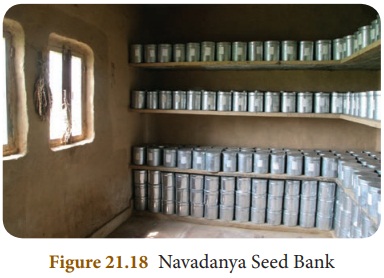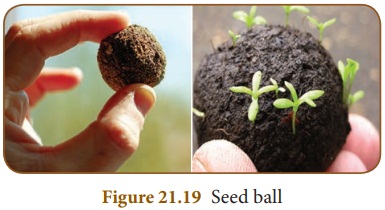Crop Production and Management | Chapter 21 | 8th Science - Seed Bank | 8th Science : Chapter 21 : Crop Production and Management
Chapter: 8th Science : Chapter 21 : Crop Production and Management
Seed Bank
Seed Bank
Seed bank is a place where seeds are
stored in order to preserve genetic diversity. Seeds may be viable for hundreds
and even thousands of years. Seed banks are like seed libraries that contain
valuable information about evolution strategies of plants.
The Royal Botanical Gardens located
in Kolkatta first started collecting seeds formally as seed bank. Seed banks
were created to store native varieties of seeds. With this initiative farmers
have started preserving indigenous seeds and reducing their dependence on
hybrid seeds from seed companies. The simple and healthiest method of seed
storage is in the air tight earthen pots. Navadanya Seed Bank, a
nongovernmental organization located in New Delhi conserve around 50,000 crop
varieties, with the primary focus on preservation of grain species.

Acharya Jagadish Chandra
Bose Indian Botanic Garden located in Kolkatta was earlier called Royal Botanic
Garden. This garden exhibits a wide variety of rare plants and a total
collection of over 12,000 specimens. The area of this garden spreads over 109
hectares.
Seed balls
Seed balls are a mixture of soil,
compost and plant seeds. These balls are thrown into land areas. With the
monsoon set in, these planted seed balls will germinate into seedling. Making
seed ball is a step towards conserving the natural ecosystems.
Seed balls are prepared by
non-government organization and enthusiastic school children to grow tree for
ecosystem restoration. The concept of seed ball has potential to increase tree
cover and also to improve the awareness among the people about conserving
plants.

Activity 5
Take some seeds of the
fruits you eat and mix it with compost. Add some clay with them and roll them
into small balls. Allow them to dry under the sun for two or three days. Take
these balls and drop them in dry and arid areas. This will help new plants to
grow. You can throw those balls while you are travelling. This will help grow
plants in areas where there is no plant cover.
Heirloom seed
An heirloom seed is the seed of
plant that has been carefully cultivated and passed down through many
generations. Heirlooms are usually planted in small, isolated communities and
they generally offer something of value to the grower. Heirloom seeds are also
called organic seeds. These seeds are generally produced from open-pollinated
plants and they transfer their unique characteristics to the descendants.
Heirloom seed are harvested, dried and stored so that one can replant them in
the following season.
The goal of preserving heirloom seed
is to prevent any type of change due to outside influence. Most vegetable and
flower varieties must be kept protected or isolated from other similar
varieties during flowering to avoid cross pollinating plants and mixing their
genes. Some vegetable varieties are self-pollinated and are grown with
virtually no danger of crossing. Synthetic fertilizers, herbicides or
pesticides are not used for organic seeds but conventional fertilizer,
herbicides and pesticides are used.
Related Topics